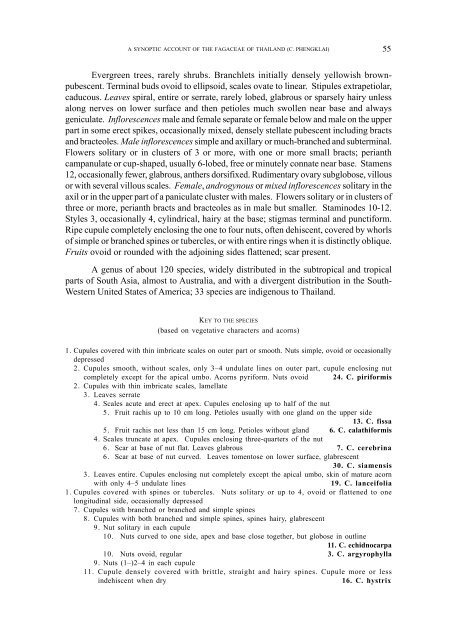A synoptic account of the Fagaceae of Thailand
A synoptic account of the Fagaceae of Thailand
A synoptic account of the Fagaceae of Thailand
You also want an ePaper? Increase the reach of your titles
YUMPU automatically turns print PDFs into web optimized ePapers that Google loves.
A SYNOPTIC ACCOUNT OF THE FAGACEAE OF THAILAND (C. PHENGKLAI) 55<br />
Evergreen trees, rarely shrubs. Branchlets initially densely yellowish brownpubescent.<br />
Terminal buds ovoid to ellipsoid, scales ovate to linear. Stipules extrapetiolar,<br />
caducous. Leaves spiral, entire or serrate, rarely lobed, glabrous or sparsely hairy unless<br />
along nerves on lower surface and <strong>the</strong>n petioles much swollen near base and always<br />
geniculate. Inflorescences male and female separate or female below and male on <strong>the</strong> upper<br />
part in some erect spikes, occasionally mixed, densely stellate pubescent including bracts<br />
and bracteoles. Male inflorescences simple and axillary or much-branched and subterminal.<br />
Flowers solitary or in clusters <strong>of</strong> 3 or more, with one or more small bracts; perianth<br />
campanulate or cup-shaped, usually 6-lobed, free or minutely connate near base. Stamens<br />
12, occasionally fewer, glabrous, an<strong>the</strong>rs dorsifixed. Rudimentary ovary subglobose, villous<br />
or with several villous scales. Female, androgynous or mixed inflorescences solitary in <strong>the</strong><br />
axil or in <strong>the</strong> upper part <strong>of</strong> a paniculate cluster with males. Flowers solitary or in clusters <strong>of</strong><br />
three or more, perianth bracts and bracteoles as in male but smaller. Staminodes 10-12.<br />
Styles 3, occasionally 4, cylindrical, hairy at <strong>the</strong> base; stigmas terminal and punctiform.<br />
Ripe cupule completely enclosing <strong>the</strong> one to four nuts, <strong>of</strong>ten dehiscent, covered by whorls<br />
<strong>of</strong> simple or branched spines or tubercles, or with entire rings when it is distinctly oblique.<br />
Fruits ovoid or rounded with <strong>the</strong> adjoining sides flattened; scar present.<br />
A genus <strong>of</strong> about 120 species, widely distributed in <strong>the</strong> subtropical and tropical<br />
parts <strong>of</strong> South Asia, almost to Australia, and with a divergent distribution in <strong>the</strong> South-<br />
Western United States <strong>of</strong> America; 33 species are indigenous to <strong>Thailand</strong>.<br />
KEY TO THE SPECIES<br />
(based on vegetative characters and acorns)<br />
1. Cupules covered with thin imbricate scales on outer part or smooth. Nuts simple, ovoid or occasionally<br />
depressed<br />
2. Cupules smooth, without scales, only 3–4 undulate lines on outer part, cupule enclosing nut<br />
completely except for <strong>the</strong> apical umbo. Acorns pyriform. Nuts ovoid 24. C. piriformis<br />
2. Cupules with thin imbricate scales, lamellate<br />
3. Leaves serrate<br />
4. Scales acute and erect at apex. Cupules enclosing up to half <strong>of</strong> <strong>the</strong> nut<br />
5. Fruit rachis up to 10 cm long. Petioles usually with one gland on <strong>the</strong> upper side<br />
13. C. fissa<br />
5. Fruit rachis not less than 15 cm long. Petioles without gland 6. C. calathiformis<br />
4. Scales truncate at apex. Cupules enclosing three-quarters <strong>of</strong> <strong>the</strong> nut<br />
6. Scar at base <strong>of</strong> nut flat. Leaves glabrous 7. C. cerebrina<br />
6. Scar at base <strong>of</strong> nut curved. Leaves tomentose on lower surface, glabrescent<br />
30. C. siamensis<br />
3. Leaves entire. Cupules enclosing nut completely except <strong>the</strong> apical umbo, skin <strong>of</strong> mature acorn<br />
with only 4–5 undulate lines 19. C. lanceifolia<br />
1. Cupules covered with spines or tubercles. Nuts solitary or up to 4, ovoid or flattened to one<br />
longitudinal side, occasionally depressed<br />
7. Cupules with branched or branched and simple spines<br />
8. Cupules with both branched and simple spines, spines hairy, glabrescent<br />
9. Nut solitary in each cupule<br />
10. Nuts curved to one side, apex and base close toge<strong>the</strong>r, but globose in outline<br />
11. C. echidnocarpa<br />
10. Nuts ovoid, regular 3. C. argyrophylla<br />
9. Nuts (1–)2–4 in each cupule<br />
11. Cupule densely covered with brittle, straight and hairy spines. Cupule more or less<br />
indehiscent when dry 16. C. hystrix
















